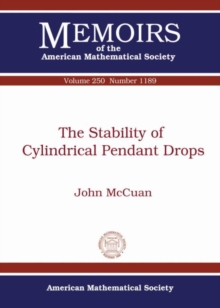
Borel Liftings of Borel Sets - Some Decidable and Undecidable Statements Paperback / softback
by Gabriel Debs, Jean Raymond
Part of the Memoirs of the American Mathematical Society series
Paperback / softback
Description
One of the aims of this work is to investigate some natural properties of Borel sets which are undecidable in $ZFC$.
The authors' starting point is the following elementary, though non-trivial result: Consider $X \subset 2omega\times2omega$, set $Y=\pi(X)$, where $\pi$ denotes the canonical projection of $2omega\times2omega$ onto the first factor, and suppose that $(\star)$ : ""Any compact subset of $Y$ is the projection of some compact subset of $X$"".
If moreover $X$ is $\mathbf{\Pi 0 2$ then $(\star\star)$: ""The restriction of $\pi$ to some relatively closed subset of $X$ is perfect onto $Y$"" it follows that in the present case $Y$ is also $\mathbf{\Pi 0 2$.
Notice that the reverse implication $(\star\star)\Rightarrow(\star)$ holds trivially for any $X$ and $Y$.
But the implication $(\star)\Rightarrow (\star\star)$ for an arbitrary Borel set $X \subset 2omega\times2omega$ is equivalent to the statement ""$\forall \alpha\in \omegaomega, \,\aleph 1$ is inaccessible in $L(\alpha)$"".
More precisely The authors prove that the validity of $(\star)\Rightarrow(\star\star)$ for all $X \in \varSigma0 {1 \xi 1 $, is equivalent to ""$\aleph \xi \aleph 1$"".
However we shall show independently, that when $X$ is Borel one can, in $ZFC$, derive from $(\star)$ the weaker conclusion that $Y$ is also Borel and of the same Baire class as $X$.
This last result solves an old problem about compact covering mappings.
In fact these results are closely related to the following general boundedness principle Lift$(X, Y)$: ""If any compact subset of $Y$ admits a continuous lifting in $X$, then $Y$ admits a continuous lifting in $X$"", where by a lifting of $Z\subset \pi(X)$ in $X$ we mean a mapping on $Z$ whose graph is contained in $X$.
The main result of this work will give the exact set theoretical strength of this principle depending on the descriptive complexity of $X$ and $Y$.
The authors also prove a similar result for a variation of Lift$(X, Y)$ in which ""continuous liftings"" are replaced by ""Borel liftings"", and which answers a question of H.
Friedman. Among other applications the authors obtain a complete solution to a problem which goes back to Lusin concerning the existence of $\mathbf{\Pi 1 1$ sets with all constituents in some given class $\mathbf{\Gamma $ of Borel sets, improving earlier results by J.
Stern and R. Sami. The proof of the main result will rely on a nontrivial representation of Borel sets (in $ZFC$) of a new type, involving a large amount of ""abstract algebra"".
This representation was initially developed for the purposes of this proof, but has several other applications.
Information
-
Out of Stock - We are unable to provide an estimated availability date for this product
- Format:Paperback / softback
- Pages:118 pages, illustrations
- Publisher:American Mathematical Society
- Publication Date:30/03/2007
- Category:
- ISBN:9780821839713
Other Formats
- PDF from £61.20
Information
-
Out of Stock - We are unable to provide an estimated availability date for this product
- Format:Paperback / softback
- Pages:118 pages, illustrations
- Publisher:American Mathematical Society
- Publication Date:30/03/2007
- Category:
- ISBN:9780821839713










